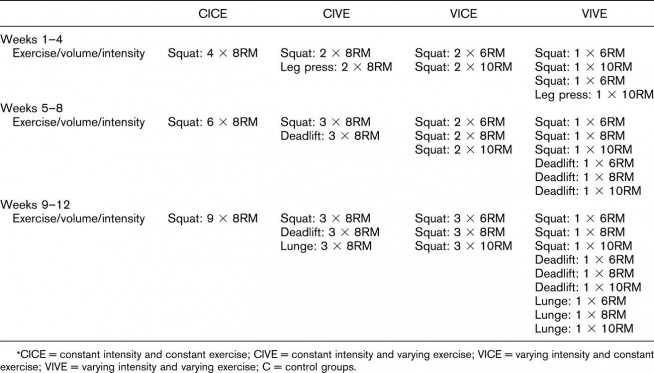Change it Up: Why Changing Exercises Is the Key to Strength Gains
Traditional training programs are based on the concept of progressive overload. You gradually increase the difficulty of an exercise by adjusting the amount of weight you lift and the number of reps you perform to promote strength and size gains. But new information is testing this widely accepted theory.
A study published in the Journal of Strength & Conditioning Research compared the effectiveness of training programs that either varied the exercise intensity or type of exercise. Thirty-nine subjects were separated into training groups that followed four different 12-week lower-body workout programs: Constant Intensity and Constant Exercise (CICE); Constant Intensity and Varying Exercises (CIVE); Varying Intensity and Constant Exercise (VICE); Varying Intensity and Varying Exercise (VIVE)—as shown below.

Source: Journal of Strength & Conditioning Research
At the conclusion of the program, the researchers assessed strength gains with a one-rep max Squat test and quadriceps size with MRI imaging. They found that all groups produced gains in both categories, but the CIVE group experienced the best results. Both varied intensity groups had the least strength and size gains.
Each group experienced muscle size gains, so the researchers concluded that muscles increase in size as long as the training program is sufficiently challenging. Both varied exercise groups experienced muscle size increases across the entire quadriceps muscle, whereas the constant exercise groups only developed a portion of the muscle.
The constant intensity groups produced better strength results than the varied intensity groups. It was thought that increasing the intensity at the start of a training program goes beyond the limitations of the body at that point, causing faulty movement patterns and limited strength production, ultimately reducing the effectiveness of the exercises. (If you have faulty movement patterns, try these four easy fixes.)
Based on this study, we can conclude that when starting a training program, it is better to work muscle groups with multiple exercises than to keep increasing the amount of weight you lift. Multiple exercises work the muscles more comprehensively while staying within your physical limitations.
However, this study focused only on the quadriceps muscle group, which contains four separate muscles. At this point, it’s unclear whether similar results would be realized in other muscle groups that don’t share this attribute.
Also, the results appear to apply only to the initial phase of a training program. Once you establish a foundation of strength, follow a more traditional progressive overload program. Remember: you can’t always do the same exercise and expect to develop comprehensive strength. Varying your workouts limits potential weaknesses or imbalances that can impair your strength and speed, or cause an injury.
RECOMMENDED FOR YOU
MOST POPULAR
Change it Up: Why Changing Exercises Is the Key to Strength Gains
Traditional training programs are based on the concept of progressive overload. You gradually increase the difficulty of an exercise by adjusting the amount of weight you lift and the number of reps you perform to promote strength and size gains. But new information is testing this widely accepted theory.
A study published in the Journal of Strength & Conditioning Research compared the effectiveness of training programs that either varied the exercise intensity or type of exercise. Thirty-nine subjects were separated into training groups that followed four different 12-week lower-body workout programs: Constant Intensity and Constant Exercise (CICE); Constant Intensity and Varying Exercises (CIVE); Varying Intensity and Constant Exercise (VICE); Varying Intensity and Varying Exercise (VIVE)—as shown below.

Source: Journal of Strength & Conditioning Research
At the conclusion of the program, the researchers assessed strength gains with a one-rep max Squat test and quadriceps size with MRI imaging. They found that all groups produced gains in both categories, but the CIVE group experienced the best results. Both varied intensity groups had the least strength and size gains.
Each group experienced muscle size gains, so the researchers concluded that muscles increase in size as long as the training program is sufficiently challenging. Both varied exercise groups experienced muscle size increases across the entire quadriceps muscle, whereas the constant exercise groups only developed a portion of the muscle.
The constant intensity groups produced better strength results than the varied intensity groups. It was thought that increasing the intensity at the start of a training program goes beyond the limitations of the body at that point, causing faulty movement patterns and limited strength production, ultimately reducing the effectiveness of the exercises. (If you have faulty movement patterns, try these four easy fixes.)
Based on this study, we can conclude that when starting a training program, it is better to work muscle groups with multiple exercises than to keep increasing the amount of weight you lift. Multiple exercises work the muscles more comprehensively while staying within your physical limitations.
However, this study focused only on the quadriceps muscle group, which contains four separate muscles. At this point, it’s unclear whether similar results would be realized in other muscle groups that don’t share this attribute.
Also, the results appear to apply only to the initial phase of a training program. Once you establish a foundation of strength, follow a more traditional progressive overload program. Remember: you can’t always do the same exercise and expect to develop comprehensive strength. Varying your workouts limits potential weaknesses or imbalances that can impair your strength and speed, or cause an injury.











